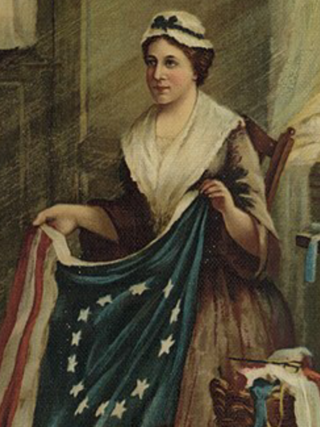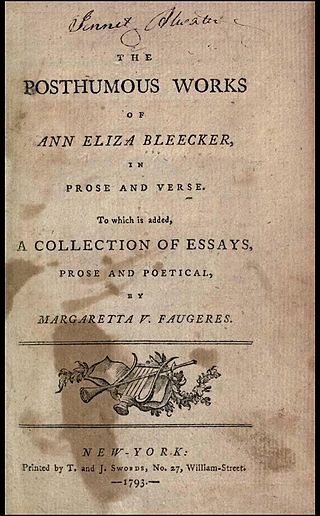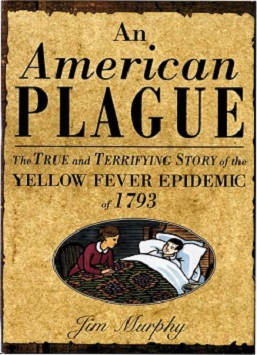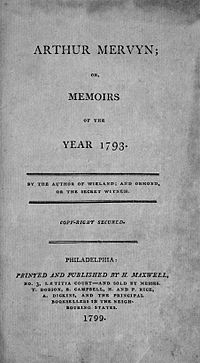
This section of the timeline of United States history concerns events from 1790 to 1819.

Charles Brockden Brown was an American novelist, historian, and editor of the Early National period.

Elizabeth Griscom Ross, also known by her second and third married names, Ashburn and Claypoole, was an American upholsterer who was credited by her relatives in 1870 with making the second official U.S. flag, accordingly known as the Betsy Ross flag. Though most historians dismiss the story, Ross family tradition holds that General George Washington, commander-in-chief of the Continental Army and two members of a congressional committee—Robert Morris and George Ross—visited Mrs. Ross in 1776. Mrs. Ross convinced George Washington to change the shape of the stars in a sketch of a flag he showed her from six-pointed to five-pointed by demonstrating that it was easier and speedier to cut the latter. However, there is no archival evidence or other recorded verbal tradition to substantiate this story of the first U.S. flag. It appears that the story first surfaced in the writings of her grandson in the 1870s, with no mention or documentation in earlier decades.

The Power of Sympathy: or, The Triumph of Nature (1789) is an 18th-century American sentimental novel written in epistolary form by William Hill Brown and is widely considered to be the first American novel. The Power of Sympathy was Brown's first novel. The characters' struggles illustrate the dangers of seduction and the pitfalls of giving in to one's passions, while advocating the moral education of women and the use of rational thinking as ways to prevent the consequences of such actions.

Tudor Place is a Federal-style mansion in Washington, D.C. that was originally the home of Thomas Peter and his wife, Martha Parke Custis Peter, a granddaughter of Martha Washington. The property, comprising one city block on the crest of Georgetown Heights, had an excellent view of the Potomac River.

Wieland: or, The Transformation: An American Tale, usually simply called Wieland, is the first major work by Charles Brockden Brown. First published in 1798, it distinguishes the true beginning of his career as a writer. Wieland is sometimes considered the first American Gothic novel. It has often been linked to Caleb Williams by William Godwin. Godwin's influence is clear, but Brown's writing is unique in its style. Wieland is often categorized under several subgenres other than gothic fiction, including horror, psychological fiction and epistolary fiction, which are listed at Project Gutenberg.

During the 1793 Yellow Fever epidemic in Philadelphia, 5,000 or more people were listed in the official register of deaths between August 1 and November 9. The vast majority of them died of yellow fever, making the epidemic in the city of 50,000 people one of the most severe in United States history. By the end of September, 20,000 people had fled the city, including congressional and executive officials of the federal government. Most did not return until after the epidemic had abated in late November. The mortality rate peaked in October before frost finally killed the mosquitoes and brought an end to the outbreak. Doctors tried a variety of treatments but knew neither the origin of the fever nor that the disease was transmitted by mosquitoes.
Eliza Parsons was an English Gothic novelist, best known for The Castle of Wolfenbach (1793) and The Mysterious Warning (1796). These are two of the seven Gothic titles recommended as reading by a character in Jane Austen's novel Northanger Abbey.
The Castle of Wolfenbach (1793) is the most famous novel written by the English Gothic novelist Eliza Parsons. First published in two volumes in 1793, it is among the seven "horrid novels" recommended by the character Isabella Thorpe in Jane Austen's novel Northanger Abbey and an important early work in the genre, predating Ann Radcliffe's The Mysteries of Udolpho and Monk Lewis's The Monk.
Dear creature! How much I am obliged to you; and when you have finished Udolpho, we will read The Italian together; and I have made out a list of ten or twelve more of the same kind for you.
Have you, indeed! How glad I am! What are they all?
I will read you their names directly; here they are, in my pocketbook. Castle of Wolfenbach, Clermont, Mysterious Warnings, Necromancer of the Black Forest, Midnight Bell, Orphan of the Rhine, and Horrid Mysteries. Those will last us some time.
Yes, pretty well; but are they all horrid, are you sure they are all horrid?

Edgar Huntly, Or, Memoirs of a Sleepwalker is a 1799 novel by the American author Charles Brockden Brown and was published by Hugh Maxwell. The novel is considered an example of early American gothic literature, with themes such as wilderness anxiety, the supernatural, darkness, and irrational thought and fear.

Look Homeward, Angel is a 1957 stage play by the playwright Ketti Frings. The play is based on Thomas Wolfe's 1929 largely autobiographical novel of the same title.

Jennie Gerhardt is a 1911 novel by Theodore Dreiser.
American gothic fiction is a subgenre of gothic fiction. Elements specific to American Gothic include: rationality versus the irrational, puritanism, guilt, the uncanny, ab-humans, ghosts, and monsters.

Margaretta Faugères was the daughter of Ann Eliza Bleecker. She was an American playwright, poet and political activist. She became distinguished after the American Revolutionary War, in New York City's fashionable society, as a gifted and accomplished woman, although her married life was rendered unhappy by a profligate husband. After his death in 1798, she assisted in a female academy in New Brunswick; but her sufferings were said to have "broken her heart". She died at the early age of twenty-nine.

The evolutionary origins of yellow fever most likely came from Africa. Phylogenetic analyses indicate that the virus originated from East or Central Africa, with transmission between primates and humans, and spread from there to West Africa. The virus as well as the vector Aedes aegypti, a mosquito species, were probably brought to the western hemisphere and the Americas by slave trade ships from Africa after the first European exploration in 1492. However, some researchers have argued that yellow fever might have existed in the Americas during the pre-Columbian period as mosquitoes of the genus Haemagogus, which is indigenous to the Americas, have been known to carry the disease.
Memoirs of Carwin, the Biloquist (1803–1805) is a story fragment written by Charles Brockden Brown and published over a period of two years in monthly installments of Brown's Literary Magazine. Brown never completed his story, and it has always remained unfinished, and unresolved. Carwin is technically the sequel to Brown's previous work, Wieland; or the Transformation, because Brown wrote it five years afterwards; however, the events in Carwin occur prior to the plot established in Wieland. Memoirs of Carwin, the Biloquist follows the life of a young man by the name of Carwin as he realizes his biloquial, or ventriloquist, talents. Carwin develops this ability to perfection, being able to manipulate his own voice to sound like any person he wants.
Sky-Walk is the first completed novel by Charles Brockden Brown. It was started in 1797 and completed by March 1798, when an “Excerpt” was published in The Weekly Magazine of Original Essays, Fugitive Pieces, and Interesting Intelligence. The novel was subsequently lost, though Brown's later novel Edgar Huntly takes up the same themes as Sky-Walk, most notably, that of sleepwalking. Like Brown's other novels, Sky-Walk is an example of the American Gothic novel.

An American Plague: The True and Terrifying Story of the Yellow Fever Epidemic of 1793 is a 2003 nonfiction adolescent history by author Jim Murphy published by Clarion Books. An American Plague was one of the finalists in the 2003 National Book Award and was a 2004 Newbery Honor Book. It portrays the agony and pain this disease brought upon the American people marking its place in history in order to never be forgotten.
Elihu Hubbard Smith was an American author, physician, and man of letters.












